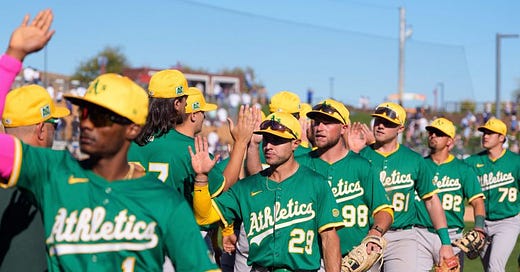Are the A's Lacking a Home Field Advantage?
With MLB's nomadic franchise lacking a true home, we dig into the numbers of home field advantage.
With the (formerly Oakland, now kind of Las Vegas–sort of) Athletics' lease at the Oakland Coliseum expiring after the 2024 season—and their planned ballpark in Vegas not expected to be ready until 2028—the team is in its first of three seasons without a true home ballpark. The Athletics will call Sacramento’s Sutter Health Park—home of the Giants’ Triple-A affiliate, the Sacramento River Cats—their “home stadium” until their eventual migration to Sin City. Sutter Health Park holds roughly 14,000 fans, just 30% of the Oakland Coliseum’s capacity of 46,847. It’s not like the A’s were drawing huge crowds in Oakland, especially in recent seasons amid widespread protests of ownership, but the fans who did attend were tried-and-true Oaklanders. Now, it will be an 80-mile, hour-and-a-half commute to see the A’s in Sacramento—assuming those disgruntled Oakland fans are willing to make the extra effort for a franchise whose management has, frankly, screwed them for years. The team’s stint in a temporary park—which, not including the Rays’ short-term stay at George M. Steinbrenner Field while Tropicana Field is repaired, will be the smallest in baseball by over 20,000 seats—led me to consider the impact of home-field advantage and home attendance on team performance.
Fans and Wins
What influence do fans have on their home team winning? Over the past 3 seasons, there is just a 0.07 correlation between park attendance and the home team winning. In terms of the percent of ballpark capacity filled, the correlation is nearly identical at 0.06. Both are miniscule, and indicate essentially no relationship between the two. Meanwhile, the average ballpark attendance when the home team wins, as well as the % capacity filled, is significantly different than when the home team loses based on a two-sample t-test.
So what gives? This doesn’t seem to jive with the low correlation. The explanation appears to lie in the fact that better teams bring more fans. The chart below plots attendance against the home team’s winning percentage from 2022 through the 2024 season.
It’s the sports equivalent of the “chicken or the egg” question: does winning games bring big crowds, or do big crowds help win games? The findings above seem to point toward an answer, but for additional support, we can apply the Granger Causality Test to team attendance and winning percentage over time to help determine whether there is a causal relationship between attendance and home-team victories. In other words: does high attendance lead to team success, or does a winning team bring out the fans?
When looking specifically at the Athletics, we find that winning percentage is a lagging indicator of attendance. However, the Granger Causality Test is not significant—far from it, with a p-value of 0.857—suggesting there is no evidence to support the claim that attendance causes changes in the team’s winning percentage.1 Also, for what it’s worth, the A’s home attendance does not differ significantly between games they win and games they lose.
The 2020 Test Case
Lets agree that 2020 was, all things considered, not exactly the best year. However, it did provide us with some interesting situations that gave unique insights we wouldn’t have otherwise had. The shortened 2020 MLB season was played without fans in the stands. So while home teams played in their home ballpark, they played without the support of tens of thousands of their fans cheering them on. Ironically, home teams performed better in 2020 than in the ensuing seasons. Even in 2021 when stadiums were at reduced capacity for the majority of the season, home teams won more often.
This all leads us to believe that the tiny capacity of the Athletics temporary park will have no impact on the team’s performance.
Home Field Advantage Across Baseball
While attendnce may not be much of a factor in home field advantage. Home teams, as we see clearly in the table above, still win more often than they lose. So there are some advantages to playing at home. Frankly you could write a book diving into all the different possible contributors, such as travel stress, familiarity with park dimentions and features, comfort of sleeping in your own home, and so on. I won’t explore those reasons here, but rather just look at which clubs benefit the most from playing in their own ballparks. The table below ranks team home field advantage by the difference between their winning percentage at home versus on the road.
Notably, the Reds, Nationals, and Astros win more on the road than they do at home. The Rockies—whose home park, Coors Field, sits 5,200 feet above sea level—unsurprisingly have the best home-field advantage by a wide margin. To circle back to the A’s, they weren’t getting much boost from playing at Oakland Coliseum anyway, winning there just 1% more often than on the road.2
If the Athletics perform poorly in Sacramento, attendance or park capacity can’t be to blame. Regarding the other less-than-ideal factors of playing in a temporary minor league facility, they may have more of an argument there.
I would have done this test for all teams, but it took extensive time and data manipulation to just do it on one. I don’t get paid enough…or, err, at all…to do if for all teams, sorry.
Based on the decrepit nature of that stadium, it is impressive that any team could win a game their at all.







